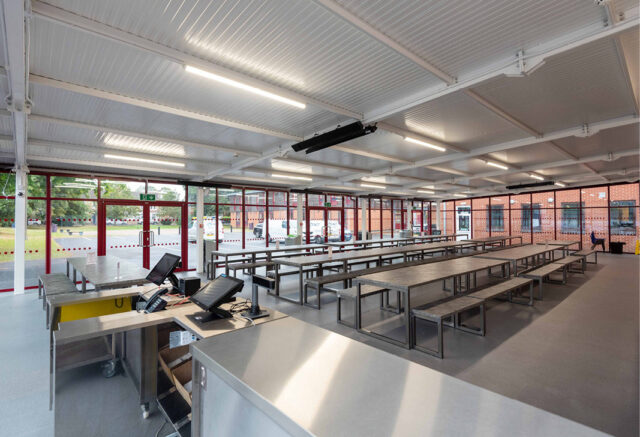Allergy UK report that around 5-8% of children in the UK live with a food allergy and most school classrooms will have at least one allergic pupil.
These young people are at risk of both mild and serve allergic reactions known as anaphylaxis, which is potentially life-threatening. There are invisible risks for these pupils too; exclusion, segregation and anxiety – due to the way their allergy is handled at school. Frustratingly, many of these ‘invisible’ risks are avoidable with efficient school planning.
It is essential that staff recognise the seriousness of allergy requirements and know how to respond safely and effectively in the case of a reaction. What’s more, it is vital that they put the appropriate measures in place to remove unnecessary barriers to a social, happy and positive lunchtime experience for pupils with allergies.
These three strategies could help to improve the dining experience of pupils in your school with food allergies:
- Encourage inclusivity and support
- Avoid overemphasising allergies
- Empower all pupils with effective systems in place
1. Encourage inclusivity and support
Every child deserves to feel included and valued in the school community. Singling out a child due to their allergies can lead to feelings of exclusion and may affect their sense of belonging. 32% of children surveyed in a recent study, reported having been bullied due to a food allergy. Fostering a culture of inclusivity and understanding among pupils and staff is vital in reducing this.
Under section 100 of the Children and Families Act 2014, schools have a duty to support pupils with medical conditions, which includes ensuring that a child with an allergy is able to eat a school lunch.
As well as constantly needing to be prepared and equipped should an interaction with their allergen occur, students with allergies often face additional social challenges. The ideal is for the allergic student to be included as a typical class member in all activities.
Instead of singling out a child, fostering an environment of empathy and understanding helps create a supportive community.
Educating pupils and all staff about allergies is incredibly important and promotes compassion. When pupils understand the importance of helping their peers manage allergies, by being mindful of shared spaces and food items, social barriers are reduced.
2. Avoid overemphasising allergies
Schools have a responsibility to strike the right balance between keeping pupils safe and creating a culture where pupils with allergies are able to participate fully.
Children with allergies want to feel like any other student, not defined solely by their condition. Emphasising inclusivity allows them to focus on learning and socialising like their peers.
Some schools operate an “Allergy table” and guidance from allergy research and charity groups suggests proceeding with great caution here…
A study at a high school in America, where the allergy table is commonplace, wrote:
“Picture lunch detention, sitting at that one round table in the cafeteria where everyone can see that you were late to school for the third time and got in trouble. Embarrassing, but you have plenty of company. Strangers, but company.
Do you know what’s more embarrassing?
Being the only one at the Allergy Table.”
Allergy tables are dedicated tables for students with allergies. Designed to avoid contact with allergens, the intention behind this type of seating arrangement is good. However, physical segregation does not allow pupils with allergies to interact with their friends in the same way as their peers and visibly singles them out.
Allergy training suggests that there are several things that can make a child with an allergy appear different to others, from the meal they are able to eat or some form of medical identification which they are asked to wear at school.
Well-intentioned lanyards, coloured vouchers; any visual indicator of the child’s allergy and their right to a safe school lunch, actually feel more like a barrier. These things can single a child out as a target for bullies, particularly if other children don’t understand the pupil’s allergies, what allergic reactions are or the potential consequences of them.
So what’s the solution?
In a busy school cafeteria, where often, well over a thousand pupils need to queue, buy and eat their school lunch within the space of about an hour, the risk to pupils with allergies is incredibly high. Yet, forcing these pupils to sit separately or display visibly that they have an allergy is also not best practice.
3. Empower all pupils
It’s vitally important to safeguard children with allergies – and when it comes to safeguarding, schools are on the front line.
Well-designed school dining areas and smart software can help to provide a solution, empowering pupils with allergies.
Self-serve, cashless catering systems are adapting so that every food and beverage product can be flagged against the 14 most common allergens. By integrating with the school management information system, data is cross-referenced against each pupil’s profile at point of sale. If an allergen is found in their selection, the system issues a warning message to that pupil only and prevents the purchase.
Not only does this allow the pupil to discreetly make a different selection, it stops them from having to be in a separate space from their peers and allows them to select their own lunch based on their individual needs. Allergy researchers stress that importantly, most pupils with allergies are extremely vigilant in what they are ingesting and are able to become excellent advocates for their own safety and inclusion.
This type of self-serve, cashless system, acknowledges and celebrates pupil independence and careful, safe management of their allergy; whilst promoting inclusivity.
Setting up a school dining hall to accommodate this type of multiple, self-service stations requires expert -planning and space.
Find out how schools we’ve worked with have turned to ZONE design.build solutions to ease their lunchtime pressures.




